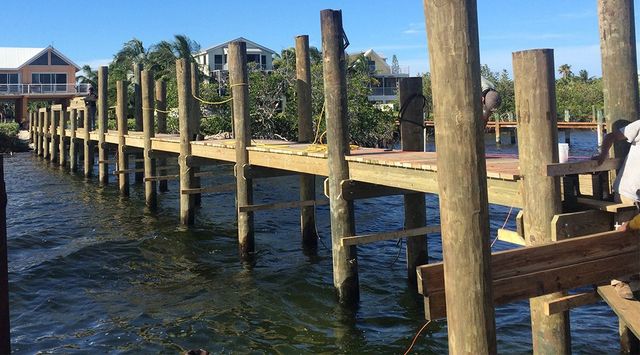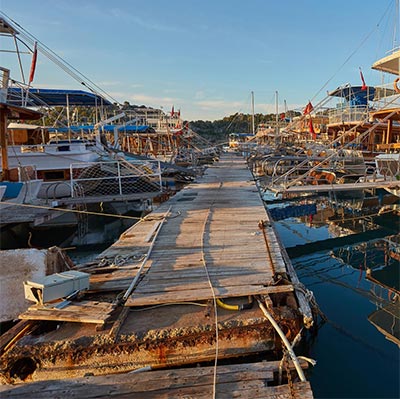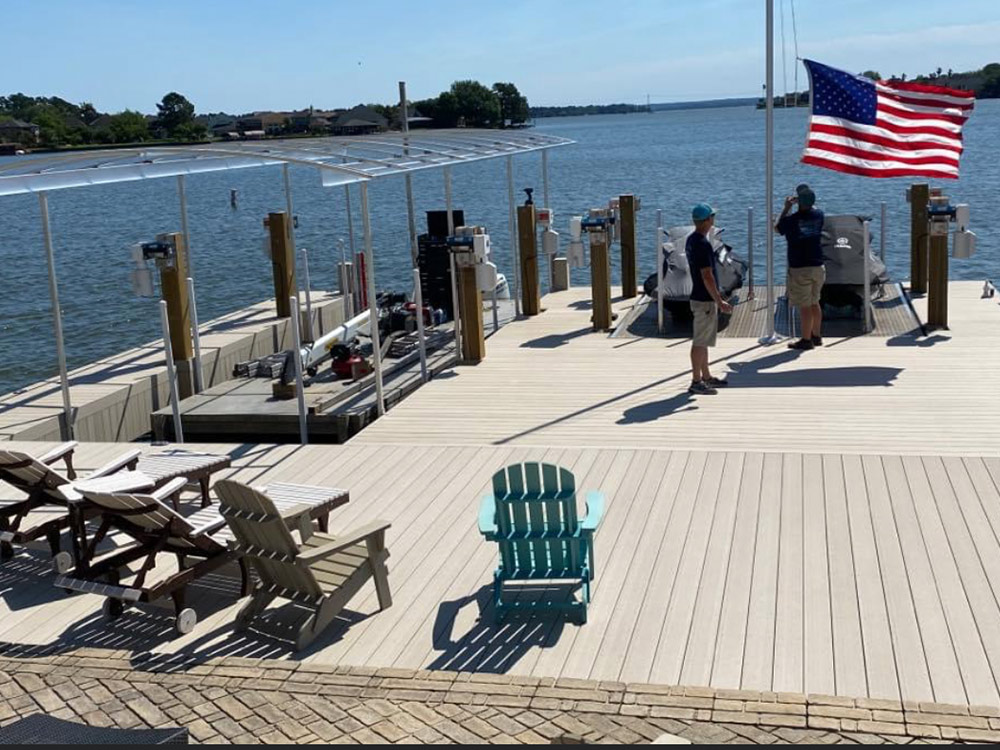Reliable Dock Fixing Techniques: Making Sure Structural Integrity
Making sure the structural integrity of docks through effective repair methods is paramount for the longevity and security of aquatic facilities. This involves a multi-faceted strategy starting with comprehensive inspections making use of advanced innovations like finder tools and from another location operated automobiles (ROVs) to spot both noticeable and hid problems. Consequently, choosing the appropriate fixing products, such as composite materials and corrosion-resistant alloys, is critical for sturdiness. Structural reinforcement approaches, consisting of the application of cross-bracing systems and load-distribution plates, play an important function in mitigating anxiety factors. The value of these methods becomes apparent when discovering advanced repair methods and preventative upkeep strategies.
Evaluating Dock Damage
Examining dock damage is an important primary step in ensuring the architectural stability and safety and security of any docking facility. This initial examination includes an extensive assessment to recognize both visible and concealed damages. Trick elements to examine include the dock's structure, pilings, decking, and hardware. Each part has to be scrutinized for indications of wear, rot, deterioration, or other forms of degradation that can endanger the structural integrity.
Structural designers or qualified inspectors commonly execute these evaluations making use of specialized devices and strategies. Underwater assessments could use sonar devices or from another location ran cars (ROVs) to detect submerged damages. Over water, aesthetic inspections are matched by utilizing moisture meters and various other analysis devices to discover underlying problems not promptly visible to the naked eye.

Picking Repair Materials
Selecting the appropriate repair work products is a critical step in the dock restoration process, one that straight influences the longevity and performance of the fixed structure. Material option have to be driven by aspects such as environmental conditions, load-bearing demands, and compatibility with existing dock components. For circumstances, wood is a standard selection for anchors due to its natural resilience and aesthetic allure. Nevertheless, selecting the best type of wood, such as pressure-treated lumber or naturally rot-resistant types like cedar or teak, is important to endure marine atmospheres.
Along with wood, composite products are increasingly popular due to their sturdiness and reduced maintenance needs. Compounds, commonly made from a blend of plastic and wood fibers, supply outstanding resistance to rot, insects, and UV damage. For steel anchors, selecting corrosion-resistant alloys such as galvanized steel or marine-grade light weight aluminum is vital to protect against corrosion and make certain architectural honesty in saline water conditions.
Epoxy resins and marine-grade sealers are crucial for repairing cracks and sealing joints, giving a waterproof obstacle and enhancing the dock's total toughness. By thoroughly choosing top notch materials, dock repair work can attain long-lasting results, thereby guarding versus future degradation and making sure risk-free, trusted use.
Structural Support Techniques
Effective structural reinforcement strategies are critical in guaranteeing the stability and durability of dock repairs. This approach is especially effective for anchors subjected to hefty lots or severe environmental conditions.
One more necessary technique is the application of fiber-reinforced polymers (FRP) These products offer high strength-to-weight ratios and outstanding resistance to rust, making them excellent for enhancing wooden or concrete docks. FRP can be used in strips or sheets and adhered with epoxy materials to boost structural stability.
Supporting and anchoring systems likewise play a crucial function in architectural support. Cross-bracing, making use of metal or wooden beams, can combat side forces, lowering swaying and motion. Securing systems, such as helical piers or driven piles, give a stable foundation by moving lots to deeper, a lot more secure soil layers.
Finally, the assimilation of load-distribution plates can assist disperse weight a lot more uniformly across the dock's surface, alleviating local anxiety points. These techniques jointly ensure that docks continue to be risk-free and durable, efficient in withstanding the rigors of their functional setting.
Advanced Repair Methods

One more sophisticated method entails undersea welding, which allows for fixings to be carried out without the requirement to dewater the area. This method is particularly beneficial for dealing with structural issues in submerged dock elements, guaranteeing marginal disruption to operations. Improved welding techniques, coupled with robotic systems, deliver accuracy and dependability, therefore expanding the life expectancy of the dock.
Furthermore, cathodic defense systems are applied to stop rust in metallic dock frameworks. By utilizing sacrificial anodes or satisfied existing systems, these methods efficiently alleviate the electrochemical processes that lead to product wear and tear.
Last but not least, progressed tracking technologies, such as structural wellness surveillance (SHM) systems, offer real-time information on the problem of dock structures. These systems enable aggressive maintenance and timely interventions, inevitably guaranteeing the lasting architectural stability more helpful hints of the dock.
Maintenance and Prevention
Upkeep and prevention are essential ideas that underpin the longevity and safety and security of dock structures. Normal examinations are critical, enabling very early discovery of deterioration, possible weak points, and ecological effects. A proactive approach, entailing regular look for deterioration, rot, and architectural shifts, minimizes costly repair work and extends the dock's functional life.
Safety nets should consist of using safety coatings to metal parts to defend against corrosion and utilizing treated wood to stand up to decay. Furthermore, making certain proper drain and ventilation can stop water build-up, which is an usual source of architectural degradation. Incorporating high quality materials and sticking to maker standards during building and repair work phases additionally play important duties in improving toughness.

Educating employees in dock upkeep best methods guarantees consistent application of safety nets. Leveraging technological developments, such as drones for inspections and sensors for real-time tracking, can better enhance maintenance efforts. By prioritizing maintenance and avoidance, dock owners can make certain structural stability, operational security, and affordable monitoring over the dock's life expectancy.
Final Thought
Finally, maintaining the structural integrity of aquatic centers demands thorough dock fixing methods. Extensive examinations using advanced devices uncover both noticeable and hid damages, while the choice of ideal repair work products enhances sturdiness. Implementing structural reinforcement techniques addresses tension factors properly. Advanced repair service techniques, coupled with routine upkeep practices, make sure the dock stays safe and functional under varied ecological problems. Embracing these approaches dramatically lengthens the life expectancy and capability of marine infrastructure.
Making sure the structural integrity of docks with reliable repair strategies is paramount for the long life and safety and security of marine facilities.Choosing the appropriate repair products is a crucial action in the dock remediation procedure, one that directly influences the long life and performance of the fixed structure.Reliable structural reinforcement methods are crucial next page in ensuring the security and longevity of dock repairs. By prioritizing upkeep and prevention, dock owners can guarantee structural honesty, operational security, and cost-efficient administration over the dock's life expectancy.
In final thought, maintaining the structural honesty of marine centers demands thorough dock repair strategies.